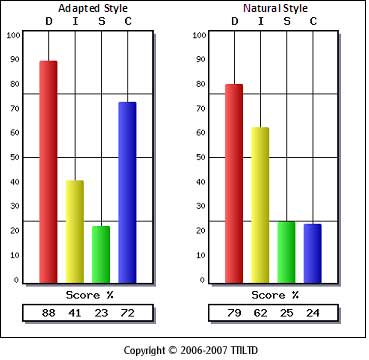I first leaned to apply the statement above when making graphic design decisions marketing media, especially websites. In that application its another way of saying “less is more.”

It can also apply to career selection. On the left is a pair of DISC charts for a person who has been doing regulatory consulting for the past decade. His natural, unmasked behavioral style is illustrated on the right chart, his adapted, working style to the left of that. In this example, were looking at the blue “C” bars and how much they differ.
Doing detail orientated regulatory/high compliance work is not a great fit for this person’s natural “C”/compliant style as shown by the score of 24 on the right chart. After 10 years of dealing with the details, he adapted his behavioral style significantly to become significantly more compliant as the job required. However a style adaption this significant will take its emotional toll. So upon noticing this on the chart, I asked him: “Have you really enjoyed doing that kind of work? He candid response: I’ve hated it!
 My logical next question was: With all of the other talents you have, why did you do it for so long? The answer lies in the next tea leaf, his motivators. His chart on the right show he is a passionate utilitarian: Driven by results and, in this case money. His answer to why he would do work that he hated for so long was simple. “People kept paying me and paying me very well. So I kept taking their money and doing it.”
My logical next question was: With all of the other talents you have, why did you do it for so long? The answer lies in the next tea leaf, his motivators. His chart on the right show he is a passionate utilitarian: Driven by results and, in this case money. His answer to why he would do work that he hated for so long was simple. “People kept paying me and paying me very well. So I kept taking their money and doing it.”
Not everyone could do this without melting down. But being so driven by the financial rewards, he was fulfilled even though, for him it was energy draining work.
So here we have a case where the DISC profile that indicated the person was not ideally suited for the job. Yet the strong motivation prevailed and he had he skills and capacities to do the job and do it well.
For those who believe that DISC analysis alone is an effective predictor of job performance, this is my exhibit one in support the case that you need a broader perspective to make effective talent decisions. That said, the question that was unasked and unanswered for ten years: “Is this a situation where we can predict star performance?” The short answer is no. To quote author Jim Collins, this is a case where “good is the enemy of great.” Somewhere outside of a highly regulated environment, there is a happier, more productive place for him.



